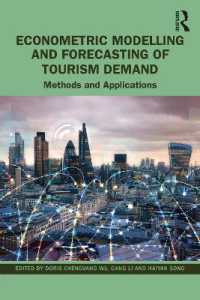- ホーム
- > 洋書
- > 英文書
- > Business / Economics
Full Description
East Asia is a key region in the global economy, including both the second and third largest global economies already and, led by China, continuing to expand at a rapid rate. This economic growth has led to unprecedented gains in prosperity in the region but it has also led to increasing environmental pressures and energy issues.
This book assesses ways in which East Asia can continue or even increase existing rates of economic growth while at the same time reducing greenhouse gas emissions and other environmental degradation. Using advanced modelling approaches, future scenarios for four East Asian countries are assessed in detail, including analysis of particular challenges in each country (e.g. coal power in China, nuclear power in Japan). Prospects for each country's energy system are assessed in detail and the potential effects of various types of Environmental Tax Reform in the four countries are also considered carefully. The final section of the book explores the interaction between trade liberalization, a key driver of growth, and emission levels in the East Asia region.
Contents
1. Energy systems and environmental policy in East Asia 2. Introduction to the modelling in this book Part 1: The Power Choices and the Sustainability of Energy Usage in East Asia 3. Modeling the Power Sectors in East Asia: The choice of Power Sources 4. Modeling the power sector in East Asia: Economic and Environmental impacts of the choices of power sources 5. The environmental and macroeconomic implications of phasing out nuclear power in Japan - E3MG vs CGE modeling results 6. Energy efficiency policies in East Asia: Macroeconomic implications and interactions with existing climate policies 7. Energy structure and energy security under climate mitigation scenarios in East Asia Part 2: Environmental Tax Reform for Environmental and Economic Balance 8. The double dividend of an environmental tax reform in East Asian economies 9. The macroeconomic impacts of ETR: A comparison of model results 10. Environmental taxes and fiscal deficits 11. The distributional effects of low carbon policies in Japan and South Korea 12. Human Capital and Environmental Taxation in Japan and South Korea 13. Competitiveness issues and carbon leakage 14. The role for border tax adjustments Part 3: Trade and Interdependency of Economy and Environment in East Asia 15. Measuring both production-based and consumption-based CO2 emissions of different countries based on the multi-region input-output model 16. An empirical study on the interdependency of energy consumption and CO2 emissions under the international IO structure of the Asia-Pacific region 17. Emissions from international maritime transportation in East Asia 18. An environmental assessment of FTA in East Asian regions using the CGE modeling approach 19. An environmental assessment of East Asian trade agreements using E3ME-Asia 20. Conclusion








